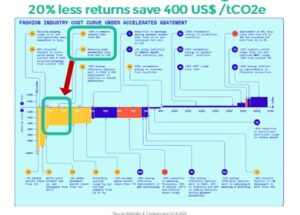In Kenneth Pucker’s insightful Business Of Fashion (BOF) article, he sheds light on the pressing challenge confronting the fashion industry as it strives for sustainable decarbonization. Pucker draws attention to a pivotal study conducted by Achim Berg’s team at McKinsey & Company, in collaboration with Global Fashion Agenda (GFA). This research, published in 2020, presented a comprehensive roadmap for the industry to achieve substantial decarbonization goals. However, regrettably, both the industry and consumers have exhibited unwavering resistance to embracing the necessary changes outlined in this roadmap.
Ken’s article three points that highlight the climate impact of the fashion industry:
- Consumer Behavior and Sustainability: The fashion industry’s greenhouse gas emissions could be significantly reduced if consumers changed their behavior. The adoption of circular models like rental and resale, reducing washing and drying, and increasing recycling could potentially lower emissions by 20 percent. For each one percent increase in circularity, carbon emissions are projected to drop by 13 million tonnes. However, the article points out that despite increasing interest in sustainable fashion among consumers, sustainability is generally not a top priority for fashion purchases. Many consumers continue to buy inexpensive, short-lived plastic apparel, contributing to environmental problems.

- Capital Allocation Challenges: The fashion industry’s decarbonization efforts require substantial capital investment, particularly in the supply chain where 60 percent of its climate impact is concentrated. Despite the potential for positive returns and high-profile commitments to decarbonization, many solutions within the supply chain remain unfunded. Brands are hesitant to invest when they may not directly benefit, suppliers change frequently, and capital costs in developing countries are high. These structural challenges hinder progress in reducing emissions within the supply chain.
- Profit vs. Planetary Welfare: The industry faces a dilemma where private profit and public welfare do not always align. While some brands have successfully reduced carbon emissions in their retail and distribution operations by switching to renewable energy, other areas like materials selection face challenges. New, lower-carbon solutions often lack the scale and cost advantages of fossil-fuel-derived materials. Externalities like pollution, microfiber shedding, and carbon emissions remain unpriced. This misalignment between profit and planetary welfare has impeded the adoption of more sustainable materials and practices.
Bodi.Me’s Fashion Fit Technology holds a piece of the puzzle to decarbonization the Fashion Industry. By integrating Size-Me into their e-commerce and ordering process, companies could reduce current returns by as little as 20%, leading to both immediate decarbonization and a cost saving of USD $ 400 per tonne of CO2 emission.

In summary, the fashion industry’s climate impact is influenced by consumer preferences, capital allocation challenges, and the conflict between profit motives and sustainability. To address these issues and reduce emissions, the industry must overcome structural barriers and work toward aligning profit with sustainability, especially as regulatory and climate pressures increase.

